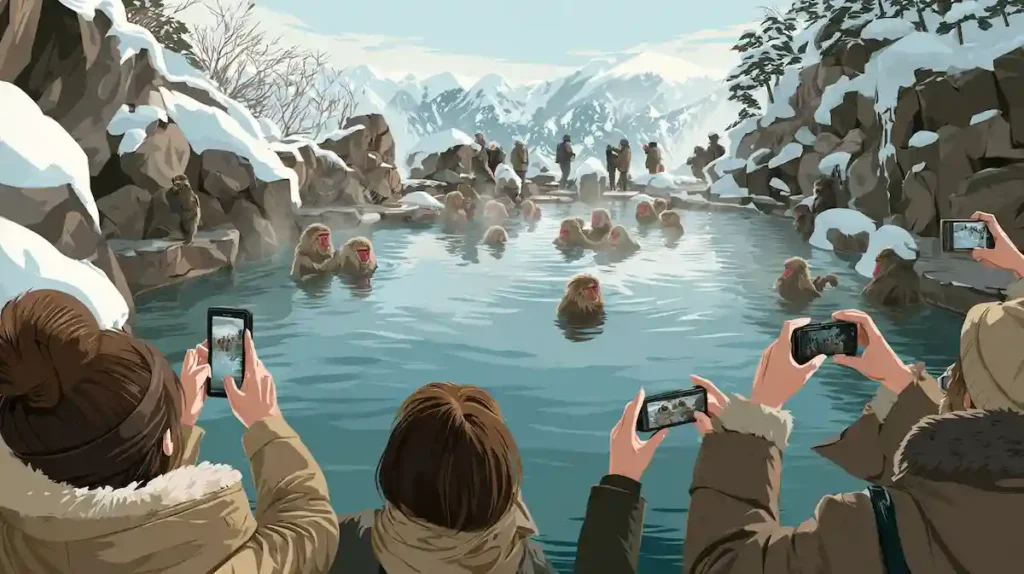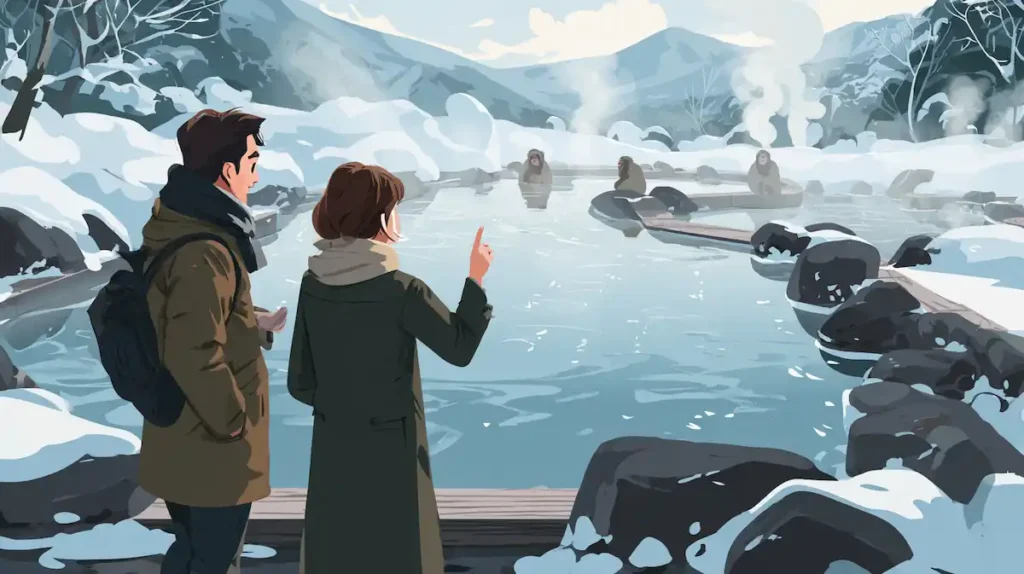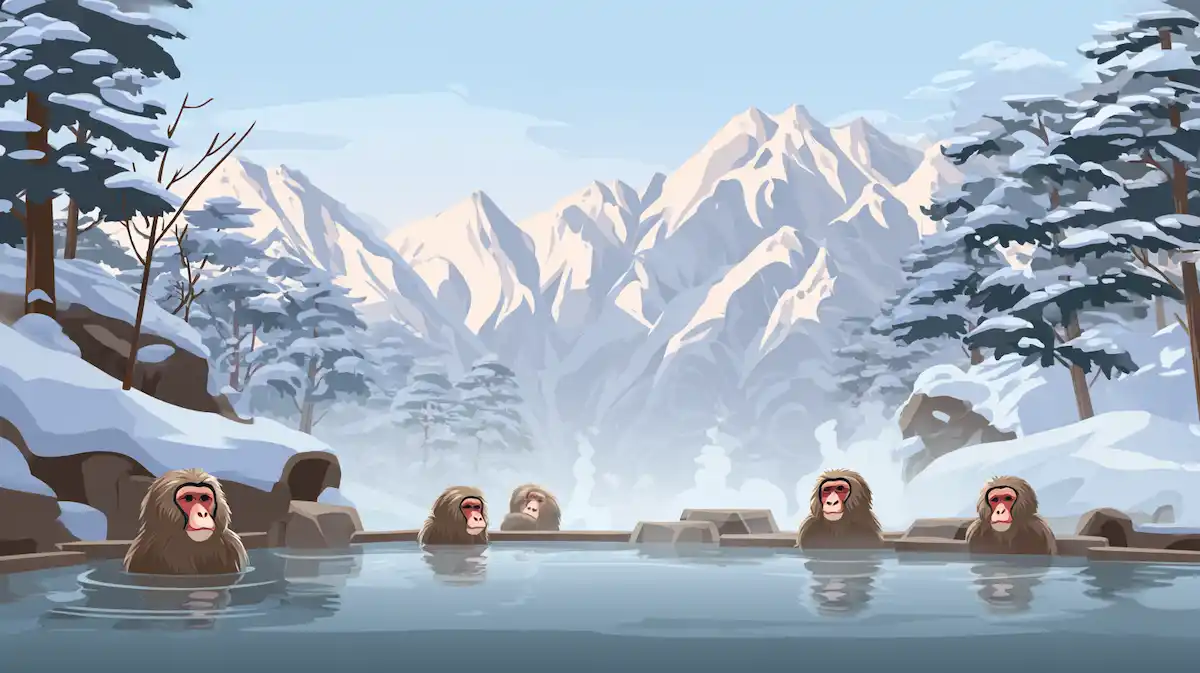地獄谷野猿公苑を英語で説明・紹介するための基本情報と、英会話に役立つ表現をシンプルでわかりやすい英語で紹介します。
英会話ダイアローグ・概要・10の質問を通して、地獄谷野猿公苑に関する英語表現を学びます。
英語
英会話ダイアローグを読む前に知っておくと良い前提知識と情報です。
- 基本情報
- 地獄谷野猿公苑は、長野県山ノ内町にある自然公苑
- 野生のニホンザルが自然環境の中で暮らす姿を観察できる
- 特徴と魅力
- 世界で唯一、野生のサルが自然の温泉に入る様子が見られる場所として有名
- 約150頭が生息し、毛づくろい・子育て・遊びなど、自然な社会行動を間近で観察できる
- 四季ごとに違った魅力があり、春は赤ちゃんザル、秋は紅葉などが楽しめる
- 人気と評価
- 世界中の旅行者が訪れ、BBCやナショナルジオグラフィックなどの番組でも紹介されている
- 海外ガイドブックでも「日本で行くべき場所」としてよく取り上げられている人気スポット
- アクセス
- 東京から北陸新幹線で長野駅 → 長野電鉄で湯田中駅 → バス → 徒歩約30分の森の遊歩道
- 周辺の観光地
- 渋温泉・湯田中温泉:伝統ある温泉街で宿泊や外湯巡りが楽しめる
- 志賀高原:スキーやハイキングが人気の高原リゾート
- 小布施町:北斎館や栗菓子が有名な歴史ある町並み
- 善光寺:長野市内にある日本を代表する古刹
2人が地獄谷野猿公苑について話しています。
スノーモンキーとして知られる野生のニホンザルが温泉に入る様子や、公苑の特徴・魅力・アクセス・周辺観光地などを話題にしています。
会話 / dialogue

Hey Key, have you ever heard of a place called Jigokudani Monkey Park in Nagano? I saw some amazing photos of monkeys bathing in hot springs.

Of course! That place is quite famous. It’s the only place in the world where wild Japanese macaques, or “snow monkeys,” soak in natural hot springs.

Really? I thought monkeys only lived in tropical forests. It’s surprising they enjoy hot water in the snow.

That’s what makes the park so special. In winter, usually from December to March, the monkeys warm themselves in the hot spring surrounded by snow. It’s an unforgettable scene.

That sounds amazing. Are they wild or kept by people?

They’re completely wild. There are no cages or fences, and they’re free to come and go as they please. You can watch their natural behavior up close.

That’s cool. How many monkeys live there?

About 150 live in the area, but the number you see depends on the day. Sometimes a whole troop gathers at the hot spring.

Why is it called “Jigokudani,” by the way? Doesn’t that mean “Hell Valley”?

Yes, exactly. The name comes from the steam and bubbling water from the hot springs rising out of the ground. It looks a bit like a hellish landscape in winter.

I like that! It gives the place a mysterious feeling. Is the park popular with tourists?

Very popular, especially with foreign visitors. It’s often featured in guidebooks and documentaries by the BBC and National Geographic.

I can see why. It must be an incredible photo spot. But is winter the only good time to visit?

Winter is definitely the highlight, but each season has its own charm. In spring, you might see baby monkeys. Summer is green and lively, and autumn brings beautiful fall colors.

That’s nice. Even if they don’t bathe in summer, watching them in nature would still be interesting.

Exactly. The park is not a zoo. It’s a place to observe how monkeys live, play, and interact in their natural habitat.

How do people get there from Tokyo? It looks pretty remote.

It’s not too hard. You take the Hokuriku Shinkansen to Nagano, then a local train to Yudanaka Station. From there, a bus and a 30-minute forest walk will take you to the park.

A forest walk sounds fun! But I guess I’ll need good shoes, especially in winter.

Definitely. The path can be snowy or slippery, so warm clothes and proper shoes are important.

Are there any other places worth visiting nearby?

Yes, lots! You can relax at Shibu Onsen or Yudanaka Onsen, visit Shiga Kogen for skiing, or explore Obuse Town, famous for Hokusai art and chestnut sweets.

Wow, it sounds like I could plan a whole trip around that area, not just a short visit.

Absolutely. Many people stay overnight, enjoy the hot springs, and spend time exploring the region after seeing the snow monkeys.

I’m already excited. Watching wild monkeys relax in hot springs must be one of the most unique experiences in Japan.

It really is. Jigokudani Monkey Park shows a side of Japanese nature and wildlife you won’t find anywhere else. You should definitely go this winter!
概要(温泉に入るスノーモンキー・地獄谷野猿公苑の魅力)
「地獄谷野猿公苑」について、理解を深めるための「英語での概要」です。
地獄谷野猿公苑

Overview
Jigokudani Monkey Park is a famous nature park located in Yamanouchi Town, northern Nagano Prefecture. It was opened in 1964 to create a safe home for wild Japanese macaques, known as “snow monkeys,” and to reduce conflicts between people and monkeys. The name “Jigokudani” means “Hell Valley” and comes from the hot steam and bubbling water that rise from the ground in the valley. The park is about 850 meters above sea level and surrounded by beautiful mountains and forests.
Unique Features
The park is world-famous because it is the only place where wild monkeys bathe in natural hot springs. Around 150 monkeys live in the area, and they are free to come and go without cages or fences. Visitors can watch them up close and observe natural behaviors such as grooming, playing, and raising their babies. The most popular time to visit is winter, from December to March, when the monkeys warm themselves in the hot water surrounded by snow.
Seasonal Charm
Each season offers different attractions. In spring, you may see baby monkeys. In summer, the green forest is beautiful, and the monkeys are active near the river. In autumn, colorful leaves create a lovely scene. Even when they do not bathe, watching the monkeys’ natural life is still fascinating.
Access and Surroundings
To reach the park, visitors usually take the Hokuriku Shinkansen from Tokyo to Nagano, then a local train to Yudanaka Station, followed by a bus and a 30-minute forest walk. Nearby, visitors can also enjoy Shibu Onsen and Yudanaka Onsen hot spring towns, the Shiga Kogen highland resort, and Obuse Town, known for Hokusai art and chestnut sweets.
10の質問(地獄谷野猿公苑の基本知識)
「地獄谷野猿公苑」について、理解を深めるための「英語での10の質問」です。
1: What is Jigokudani Monkey Park?
Jigokudani Monkey Park is a nature park in Yamanouchi Town, Nagano Prefecture, where wild Japanese macaques, called “snow monkeys,” live freely and can be seen bathing in hot springs.
2: When was Jigokudani Monkey Park opened?
It was opened in 1964 to give the monkeys a safe habitat and reduce conflicts between people and monkeys.
3: Why is it called “Jigokudani”?
The name means “Hell Valley” and comes from the hot steam and bubbling water rising from the ground in the valley.
4: Why is the park famous?
It is world-famous because it is the only place where wild monkeys bathe in natural hot springs, especially in winter.
5: When is the best time to visit the park?
The best time is winter, from December to March, when the monkeys warm themselves in the hot springs surrounded by snow.
6: How many monkeys live in the park?
About 150 monkeys live in the area, but the number you can see changes from day to day.
7: How can visitors reach the park from Tokyo?
Visitors can take the Hokuriku Shinkansen to Nagano, then a local train to Yudanaka Station, followed by a bus and a 30-minute forest walk.
8: What can visitors observe at the park?
They can observe the monkeys’ natural behaviors such as grooming, playing, and raising their babies.
9: What makes the park attractive in other seasons?
In spring you can see baby monkeys, in summer the forest is lush and green, and in autumn colorful leaves make the scenery beautiful.
10: Are there other places to visit near the park?
Yes, nearby are Shibu Onsen and Yudanaka Onsen hot spring towns, Shiga Kogen for skiing, and Obuse Town known for Hokusai art and chestnut sweets.

和訳付
会話 / dialogue

Hey Key, have you ever heard of a place called Jigokudani Monkey Park in Nagano? I saw some amazing photos of monkeys bathing in hot springs.
ねえキー、長野にある「地獄谷野猿公苑」って知ってる?温泉に入ってるサルのすごい写真を見たんだ。

Of course! That place is quite famous. It’s the only place in the world where wild Japanese macaques, or “snow monkeys,” soak in natural hot springs.
もちろん!すごく有名な場所だよ。野生のニホンザル、いわゆる「スノーモンキー」が自然の温泉に入る世界で唯一の場所なんだ。

Really? I thought monkeys only lived in tropical forests. It’s surprising they enjoy hot water in the snow.
本当?サルって熱帯の森に住んでるイメージだったよ。雪の中でお湯に入るなんてびっくりだね。

That’s what makes the park so special. In winter, usually from December to March, the monkeys warm themselves in the hot spring surrounded by snow. It’s an unforgettable scene.
それがこの公苑の特別なところなんだ。冬、だいたい12月から3月にかけて、サルたちは雪に囲まれた温泉で体を温めるんだよ。忘れられない光景だよ。

That sounds amazing. Are they wild or kept by people?
すごいなあ。それって野生なの?それとも人が飼ってるの?

They’re completely wild. There are no cages or fences, and they’re free to come and go as they please. You can watch their natural behavior up close.
完全に野生だよ。檻もフェンスもなくて、自由に行き来してるんだ。自然な行動を間近で観察できるよ。

That’s cool. How many monkeys live there?
それはいいね。そこには何頭くらいのサルがいるの?

About 150 live in the area, but the number you see depends on the day. Sometimes a whole troop gathers at the hot spring.
およそ150頭がその地域に住んでるけど、見られる数は日によって違うよ。ときには群れ全体が温泉に集まることもあるんだ。

Why is it called “Jigokudani,” by the way? Doesn’t that mean “Hell Valley”?
ところで、なんで「地獄谷」って呼ばれてるの?“Hell Valley”って意味だよね?

Yes, exactly. The name comes from the steam and bubbling water from the hot springs rising out of the ground. It looks a bit like a hellish landscape in winter.
そうそう。その名前は、地面から立ち上る温泉の湯気や熱湯の光景に由来しているんだ。冬はまるで地獄のような景色に見えるんだよ。

I like that! It gives the place a mysterious feeling. Is the park popular with tourists?
それいいね!ちょっと神秘的な感じがするよ。観光客にも人気なの?

Very popular, especially with foreign visitors. It’s often featured in guidebooks and documentaries by the BBC and National Geographic.
とても人気だよ、特に外国人観光客にね。BBCとかナショナルジオグラフィックのドキュメンタリーやガイドブックにもよく登場するんだ。

I can see why. It must be an incredible photo spot. But is winter the only good time to visit?
それは納得だね。絶好の写真スポットになりそう。でも、冬だけが行くのにいい時期なの?

Winter is definitely the highlight, but each season has its own charm. In spring, you might see baby monkeys. Summer is green and lively, and autumn brings beautiful fall colors.
冬が一番の見どころだけど、どの季節にも魅力があるよ。春は赤ちゃんザルが見られるかもしれないし、夏は緑がいっぱいでにぎやか、秋は紅葉がとてもきれいなんだ。

That’s nice. Even if they don’t bathe in summer, watching them in nature would still be interesting.
それはいいね。夏に温泉に入らなくても、自然の中で観察するだけでも楽しそうだよ。

Exactly. The park is not a zoo. It’s a place to observe how monkeys live, play, and interact in their natural habitat.
その通り。あそこは動物園じゃないんだ。サルが自然の中でどう暮らし、遊び、関わっているかを観察できる場所なんだよ。

How do people get there from Tokyo? It looks pretty remote.
東京からだとどうやって行くの?けっこう山奥っぽいけど。

It’s not too hard. You take the Hokuriku Shinkansen to Nagano, then a local train to Yudanaka Station. From there, a bus and a 30-minute forest walk will take you to the park.
そんなに難しくないよ。北陸新幹線で長野まで行って、そこからローカル線で湯田中駅へ。さらにバスに乗って、森の中を30分くらい歩けば公苑に着くよ。

A forest walk sounds fun! But I guess I’ll need good shoes, especially in winter.
森の中を歩くなんて楽しそう!でも冬はちゃんとした靴が必要だね。

Definitely. The path can be snowy or slippery, so warm clothes and proper shoes are important.
その通り。道が雪で滑りやすいこともあるから、暖かい服装と歩きやすい靴が大事だよ。

Are there any other places worth visiting nearby?
その近くに、ほかに行ってみる価値のある場所ってある?

Yes, lots! You can relax at Shibu Onsen or Yudanaka Onsen, visit Shiga Kogen for skiing, or explore Obuse Town, famous for Hokusai art and chestnut sweets.
たくさんあるよ!渋温泉や湯田中温泉でゆっくりしたり、志賀高原でスキーを楽しんだり、小布施で北斎の美術館や栗のお菓子を味わったりできるよ。

Wow, it sounds like I could plan a whole trip around that area, not just a short visit.
すごいね、それなら日帰りじゃなくて、1泊2日くらいでしっかり旅を計画できそうだ。

Absolutely. Many people stay overnight, enjoy the hot springs, and spend time exploring the region after seeing the snow monkeys.
その通りだよ。多くの人が1泊して温泉に入ったり、スノーモンキーを見たあとに周辺を散策したりして過ごしているよ。

I’m already excited. Watching wild monkeys relax in hot springs must be one of the most unique experiences in Japan.
もうワクワクしてきたよ。野生のサルが温泉でくつろぐ姿を見るなんて、日本でもなかなかできない体験だね。

It really is. Jigokudani Monkey Park shows a side of Japanese nature and wildlife you won’t find anywhere else. You should definitely go this winter!
本当にそうだよ。地獄谷野猿公苑では、ほかでは見られない日本の自然と野生動物の姿が見られるんだ。今冬、ぜひ行ってみて!
概要(温泉に入るスノーモンキー・地獄谷野猿公苑の魅力)
地獄谷野猿公苑

Overview
Jigokudani Monkey Park is a famous nature park located in Yamanouchi Town, northern Nagano Prefecture. It was opened in 1964 to create a safe home for wild Japanese macaques, known as “snow monkeys,” and to reduce conflicts between people and monkeys. The name “Jigokudani” means “Hell Valley” and comes from the hot steam and bubbling water that rise from the ground in the valley. The park is about 850 meters above sea level and surrounded by beautiful mountains and forests.
地獄谷野猿公苑は、長野県北部の山ノ内町にある有名な自然公苑です。1964年に開設され、「スノーモンキー」として知られる野生のニホンザルの安全な生息地をつくり、人間との衝突を減らすことを目的としています。「地獄谷」という名前は「Hell Valley(地獄の谷)」という意味で、谷から立ち上る温泉の湯気や熱湯の光景に由来します。公苑は標高約850メートルに位置し、美しい山々と森に囲まれています。
Unique Features
The park is world-famous because it is the only place where wild monkeys bathe in natural hot springs. Around 150 monkeys live in the area, and they are free to come and go without cages or fences. Visitors can watch them up close and observe natural behaviors such as grooming, playing, and raising their babies. The most popular time to visit is winter, from December to March, when the monkeys warm themselves in the hot water surrounded by snow.
この公苑は、野生のサルが自然の温泉に入る唯一の場所として世界的に有名です。およそ150頭のサルがこの地域に生息しており、檻やフェンスがないため自由に出入りしています。来園者は、毛づくろいや遊び、子育てなど、自然な行動を間近で観察することができます。最も人気のある訪問時期は12月から3月の冬で、サルたちが雪に囲まれた温泉で体を温める姿が見られます。
Seasonal Charm
Each season offers different attractions. In spring, you may see baby monkeys. In summer, the green forest is beautiful, and the monkeys are active near the river. In autumn, colorful leaves create a lovely scene. Even when they do not bathe, watching the monkeys’ natural life is still fascinating.
季節ごとに異なる魅力があります。春には赤ちゃんザルが見られるかもしれません。夏は緑豊かな森が美しく、サルたちは川辺で活発に動きます。秋は紅葉が美しい景色を作り出します。たとえ温泉に入っていなくても、サルたちの自然な生活を観察することはとても興味深いです。
Access and Surroundings
To reach the park, visitors usually take the Hokuriku Shinkansen from Tokyo to Nagano, then a local train to Yudanaka Station, followed by a bus and a 30-minute forest walk. Nearby, visitors can also enjoy Shibu Onsen and Yudanaka Onsen hot spring towns, the Shiga Kogen highland resort, and Obuse Town, known for Hokusai art and chestnut sweets.
公苑へ行くには、通常、東京から北陸新幹線で長野へ行き、そこからローカル線で湯田中駅へ向かいます。その後バスに乗り、約30分の森の遊歩道を歩いて公苑に到着します。近隣には、伝統的な温泉街である渋温泉や湯田中温泉、高原リゾートの志賀高原、北斎の芸術や栗菓子で知られる小布施町などもあり、合わせて楽しむことができます。
10の質問(地獄谷野猿公苑の基本知識)
1: What is Jigokudani Monkey Park?
地獄谷野猿公苑とは何ですか?
Jigokudani Monkey Park is a nature park in Yamanouchi Town, Nagano Prefecture, where wild Japanese macaques, called “snow monkeys,” live freely and can be seen bathing in hot springs.
地獄谷野猿公苑は、長野県山ノ内町にある自然公苑で、「スノーモンキー」と呼ばれる野生のニホンザルが自由に暮らし、温泉に入る姿を観察することができます。
2: When was Jigokudani Monkey Park opened?
地獄谷野猿公苑はいつ開設されましたか?
It was opened in 1964 to give the monkeys a safe habitat and reduce conflicts between people and monkeys.
1964年に開設され、サルたちに安全な生息地を提供し、人とサルの衝突を減らすために作られました。
3: Why is it called “Jigokudani”?
なぜ「地獄谷」と呼ばれるのですか?
The name means “Hell Valley” and comes from the hot steam and bubbling water rising from the ground in the valley.
その名前は「Hell Valley(地獄の谷)」という意味で、谷から立ち上る温泉の湯気や熱湯の光景に由来しています。
4: Why is the park famous?
この公苑はなぜ有名なのですか?
It is world-famous because it is the only place where wild monkeys bathe in natural hot springs, especially in winter.
この公苑は、特に冬に野生のサルが自然の温泉に入る世界で唯一の場所として有名です。
5: When is the best time to visit the park?
訪れるのに最適な時期はいつですか?
The best time is winter, from December to March, when the monkeys warm themselves in the hot springs surrounded by snow.
最適な時期は12月から3月の冬で、サルたちが雪に囲まれた温泉で体を温める姿が見られます。
6: How many monkeys live in the park?
この公苑には何頭のサルが生息していますか?
About 150 monkeys live in the area, but the number you can see changes from day to day.
約150頭のサルがこの地域に住んでいますが、見られる数は日によって変わります。
7: How can visitors reach the park from Tokyo?
東京からはどのように行くことができますか?
Visitors can take the Hokuriku Shinkansen to Nagano, then a local train to Yudanaka Station, followed by a bus and a 30-minute forest walk.
北陸新幹線で長野まで行き、そこからローカル線で湯田中駅へ行きます。その後、バスに乗り約30分の森の道を歩いて公苑に到着します。
8: What can visitors observe at the park?
来園者は公苑で何を観察できますか?
They can observe the monkeys’ natural behaviors such as grooming, playing, and raising their babies.
来園者は、毛づくろいや遊び、子育てなど、サルたちの自然な行動を観察することができます。
9: What makes the park attractive in other seasons?
冬以外の季節にはどのような魅力がありますか?
In spring you can see baby monkeys, in summer the forest is lush and green, and in autumn colorful leaves make the scenery beautiful.
春には赤ちゃんザルが見られ、夏は緑豊かな森が広がり、秋は紅葉が美しい景色を作り出します。
10: Are there other places to visit near the park?
公苑の近くには他に訪れるべき場所がありますか?
Yes, nearby are Shibu Onsen and Yudanaka Onsen hot spring towns, Shiga Kogen for skiing, and Obuse Town known for Hokusai art and chestnut sweets.
はい、近くには渋温泉や湯田中温泉といった温泉街や、スキーで有名な志賀高原、北斎の美術や栗菓子で知られる小布施町などがあります。

words & phrases
英会話ダイアローグと関連情報に出てきた単語・フレーズです(例文は各3つ)。

bathing : 名詞・動名詞 /ˈbeɪ.ðɪŋ/
意味: 入浴、水に入ること。The act of washing or relaxing in water.
(温泉に入っているサルの様子を指す)
例文:
- The snow monkeys are bathing in the hot spring.
「スノーモンキーは温泉に入っています。」 - People enjoy bathing in hot springs during winter.
「人々は冬に温泉に入るのを楽しみます。」 - Ancient Romans were famous for their public bathing culture.
「古代ローマ人は公衆浴場文化で有名でした。」
hellish : 形容詞 /ˈhel.ɪʃ/
意味: 地獄のような、ひどく厳しい。Extremely unpleasant or resembling hell.
(地獄谷の湯けむり立ちのぼる風景を形容する)
例文:
- The valley looked hellish with all the steam rising.
「湯気が立ちこめて谷は地獄のように見えました。」 - The soldiers went through hellish conditions in the battle.
「兵士たちは戦闘で地獄のような状況を経験しました。」 - Working in that factory was a hellish experience.
「あの工場で働くのは地獄のような体験でした。」
lively : 形容詞 /ˈlaɪv.li/
意味: 活気のある、元気いっぱい。Full of life, energy, and activity.
(観光客でにぎやかな雰囲気を表す)
例文:
- The hot spring area was very lively with tourists.
「温泉エリアは観光客でとてもにぎやかでした。」 - She has a lively personality.
「彼女は活発な性格をしています。」 - The festival became more lively after dark.
「祭りは夜になるとさらに活気づきました。」
bathe : 動詞 /beɪð/
意味: 入浴する、水浴びする。To wash or relax in water.
(サルが温泉に入ることを指す)
例文:
- The monkeys often bathe in the hot spring to stay warm.
「サルたちは体を温めるためによく温泉に入ります。」 - He likes to bathe in the river during summer.
「彼は夏に川で泳ぐのが好きです。」 - The child was bathed by his mother every evening.
「その子供は毎晩母親に入浴させてもらいました。」
slippery : 形容詞 /ˈslɪp.ər.i/
意味: 滑りやすい。Difficult to walk on because it is wet, icy, or smooth.
(冬の森の遊歩道が雪や氷で滑りやすいことを指す)
例文:
- The path to the park can be very slippery in winter.
「公苑への道は冬にとても滑りやすくなります。」 - The floor is wet and slippery, be careful!
「床が濡れて滑りやすいので気をつけて!」 - Driving on an icy road is dangerous because it’s slippery.
「氷の張った道路を運転するのは危険です。滑りやすいからです。」
